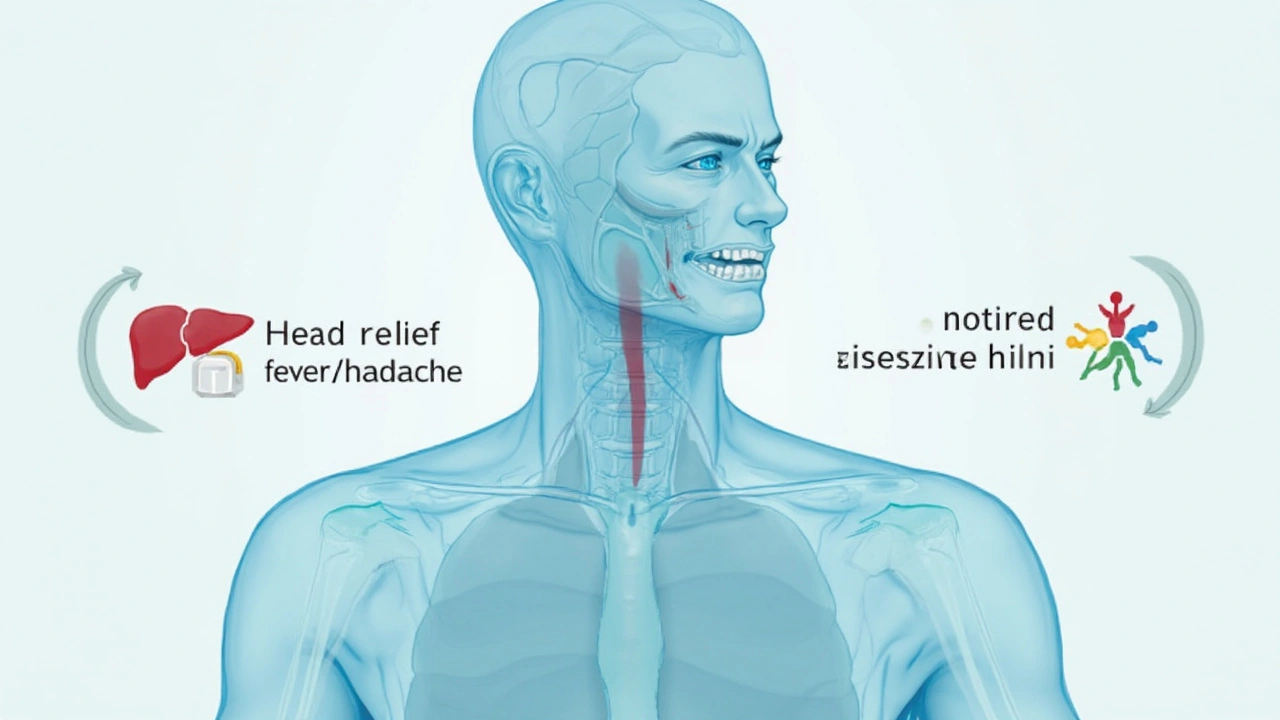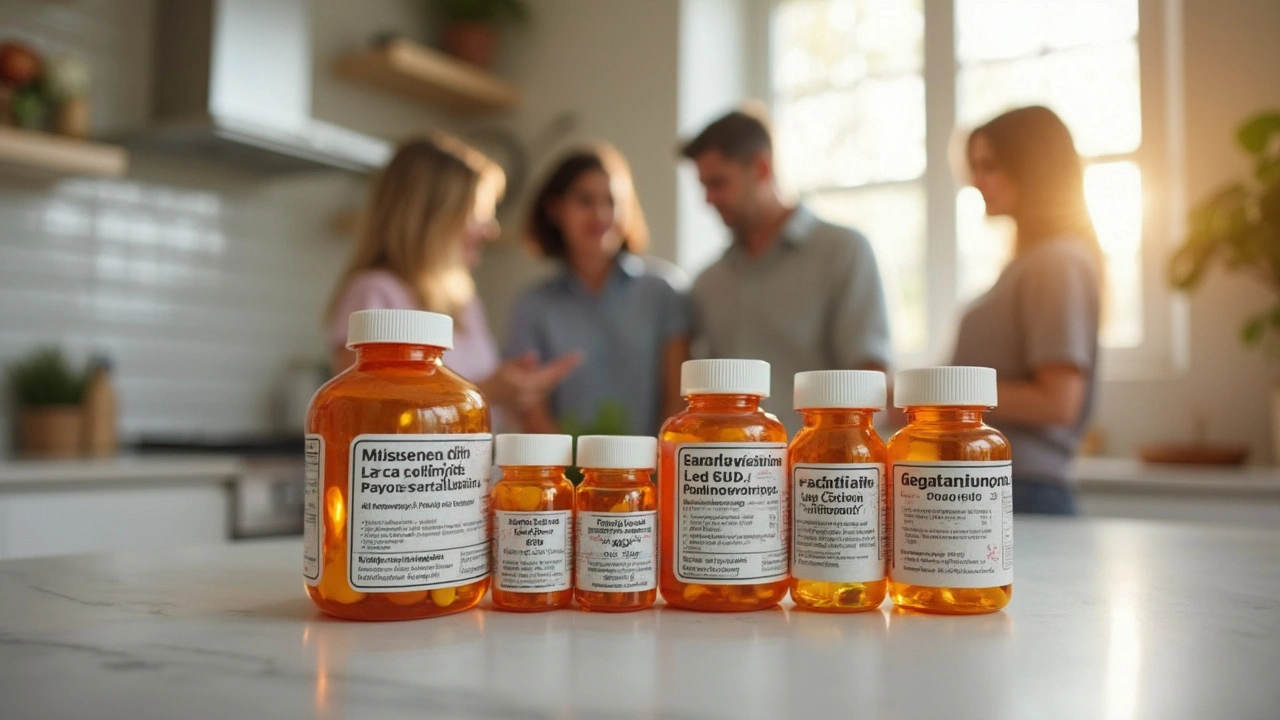Every second, someone around you is probably taking a dose of acetaminophen without a second thought. It hides in every corner of the medicine aisle, packed into everything from standard fever reducers to night-time cold relief tablets. It’s the quiet workhorse of painkillers—reliable, not flashy, and often underestimated. And yet, it’s powerful enough to save your day or, in rare cases, put your health at serious risk. So, how does such a ‘safe’ pill sit at the top of the list for accidental overdose? That’s the paradox we’re getting into: all the helpful and hidden sides of acetaminophen.
What Is Acetaminophen and How Does It Work?
Acetaminophen, also known globally as paracetamol, is that white tablet in your bag labeled “Tylenol” or hiding in countless other brand names. But what makes it tick? It doesn’t fight inflammation like ibuprofen. Instead, it zaps pain and brings down fevers by acting on your brain’s heat and pain centers. Scientists are still unraveling the full story, but the main idea: acetaminophen blocks certain chemical messengers—prostaglandins—in your brain that signal pain and cause fever. It’s like a volume knob for discomfort, but without turning down the inflammation that comes with injuries or arthritis.
Its unique action keeps it ultra popular. You’ll find it in over 600 different products in the U.S. alone. Hospitals reach for it as a first line treatment after surgeries, while parents trust it for their kids’ post-vaccine fevers or those nights when a cold won’t quit. One of its biggest strengths? You can usually take it with other common medications—like ibuprofen or antibiotics—without worry about disastrous interactions. However, some folks combine it unknowingly, and that’s where real problems start. Twice the medicine, twice the risk, and your liver can’t always keep up.
For quick relief from headaches, muscle aches, menstrual cramps, minor arthritis pain, or to lower a fever—that’s where acetaminophen shines. It starts working within 30 to 60 minutes, and you’ll feel the peak effect in about two hours. But it’s not just for humans. Vets sometimes use it for pets in tiny doses, though you should never try that without guidance. Another cool fact: it’s safer than aspirin for people with bleeding risks or stomach ulcers since it won’t irritate the gut lining.
But there are limits. Unlike some heavy-hitters, acetaminophen can’t tackle swelling from bruises or sprains. For that, you’re better off with anti-inflammatories like ibuprofen or naproxen. But for everyday aches, it’s the go-to, especially for folks who need to avoid those stomach-damaging meds. And unlike most pain relievers, acetaminophen isn’t known to raise blood pressure or trigger asthma in most people, making it a good pick for those with certain medical issues.
Dosage: What’s Safe, What’s Not, and Smart Tips
Here’s where things get personal: dosing. The number one rule with acetaminophen? Respect the max or you could wreck your liver. For adults, the typical safe limit is 4,000 mg per day, but a lot of doctors say to keep it around 3,000 mg to stay extra safe. Kids’ doses depend on their weight, not their age, so don’t just eyeball it. A common pediatric dose is 10–15 mg per kilogram of body weight every 4-6 hours, without crossing five total doses in 24 hours. Here’s what that looks like for reference:
| Population | Single Dose Range | Max Daily Dose |
|---|---|---|
| Adults | 500–1,000 mg | 3,000–4,000 mg |
| Children (by weight) | 10–15 mg/kg | 75 mg/kg |
| Older Adults | Lower end of adult range | 2,000–3,000 mg |
Got a bad headache and reaching for that nighttime cold medicine plus regular Tylenol? Time out. Most multi-symptom cold and flu remedies, allergy pills, and even some prescription pain meds have acetaminophen baked in. Always flip the box over and add up the total. Accidental doubling up is way more common than you’d think, especially for people juggling multiple meds or grabbing different brands, not realizing they share the same main ingredient.
If you drink more than two alcoholic drinks a day, the max daily dose drops—sometimes even by half. Alcohol and acetaminophen both use the liver’s detox machinery, so too much of both at once can silently bump up your risk of liver damage. The story’s even trickier for people with liver disease, hepatitis, or folks over 65. For them, smaller doses are safer. Don’t eyeball liquid medicines. Use the dosing cup or a real medicine syringe so you don’t end up guessing and overdosing by accident. Forget regular kitchen teaspoons—they’re wildly inconsistent.
And if chronic pain is your issue, talk to your doctor before popping acetaminophen daily. While it’s safe for short-term use during colds, period cramps, or a headache day, daily use for months or years needs close watch to avoid long-term risks. Another tip: space out your doses by at least four hours. Stacking them up faster doesn’t fix pain faster—it just puts your liver in the hot seat.

Risks, Side Effects, and When to Worry
When used right, acetaminophen hardly causes side effects for most folks. That’s a big reason it’s handed out so easily. But there’s always a flip side—especially if you ignore the dose. The scary part? There’s no “I can feel it coming” warning before things go wrong. The liver damage from too much acetaminophen often starts out nearly silent. You may have vague stomach pain or nausea, maybe some loss of appetite. By the time the liver’s in real trouble, it’s a full-blown medical emergency. The CDC points out that acetaminophen overdose sends about 56,000 Americans to the ER every year, and leads to over 450 deaths. In fact, it’s the number one cause of acute liver failure in North America.
People who are most at risk? Anyone who accidentally doubles up, kids who swallow an adult pill, heavy drinkers, people with chronic liver disease, and those pushing the daily limit for days or weeks instead of the recommended short bursts. Even one single massive dose—say, swallowing a whole bottle during a rough night—can be deadly if not treated within 8-24 hours. But smaller repeated overdoses add up too, sometimes slipping under the radar until the damage is done. If you ever suspect an overdose, get medical help right away, even before symptoms show up. Doctors can give an antidote called N-acetylcysteine, but it only works best if started early.
Allergies to acetaminophen do happen, though super rare—think rash, swelling, or trouble breathing. If your skin starts to peel, or you see blisters, get to a hospital (these could be signs of a serious reaction called Stevens-Johnson syndrome, but it’s extremely rare). Most people never see these, but the information can literally save your life or your child’s.
A key reminder for parents: infant and children’s products are sometimes nearly identical, just packaged differently. Always check the concentration and the dosing details—mix-ups can lead to big problems fast. And no matter what, don’t share adult-strength meds with a child assuming “it’s all the same.”
Safe Use Beyond the Basics: Tips and Surprising Facts
Did you know that your genetics might play a role in how your liver handles acetaminophen? About 1 in 10 people have genetic tweaks that slow down how their body clears it out, raising their risk for side effects. While most people won’t ever notice, it explains why some have bad reactions after seemingly normal doses.
Also, if you’re pregnant, good news: acetaminophen is usually considered the safest pain reliever to reach for (but always get the all-clear from your OB). Ibuprofen and aspirin aren’t recommended in pregnancy, especially in the third trimester. Still, the dose and frequency matter—a single dose for headaches is fine, but daily use isn’t a “free pass,” and more recent studies are looking at whether long-term use could have side effects on developing babies.
If you’re a pet lover, acetaminophen is deadly for cats and risky for dogs. Even small doses can kill a cat, so never give your furry friend pain pills meant for people unless a veterinarian prescribes and doses it. If a pet accidentally swallows any, see the vet fast—don’t just wait and see.
One of the weirdest facts: lots of “all-natural” or herbal remedies claim to be safe, but some interact with acetaminophen in ways doctors are only starting to discover. St. John’s Wort, for example, can change how your body processes a ton of common meds, including this one.
Traveling? In the EU and Australia, you can buy acetaminophen (often called paracetamol) in smaller packets only, for exact this reason—people were overdosing too easily with bulk bottles. Imagine: UK pharmacies are only allowed to sell you 32 tablets at once. That policy helped cut down accidental poisoning cases—a simple fix that speaks volumes.
Finally, watch for changes in how pain medicines are labeled. By June 2025, most manufacturers are updating labels to say “acetaminophen” more clearly so you know exactly what you’re getting in every bottle or box. It’s a step in the right direction, but it still takes a sharp eye and some daily math to stay on top of your total intake.
Remember—while acetaminophen is often the safest, easiest medicine for pain and fever, it’s not harmless. Treat it like you’d treat a sharp kitchen knife: useful, but never to be taken lightly. As always, when in doubt, check with your doctor or pharmacist, especially if you’re taking other meds, have underlying health issues, or just want to play it extra safe. That peace of mind is worth more than any pain-free day.








Edward Batchelder June 12, 2025
Acetaminophen is one of those things you never think about until you need it-or until you almost lose someone because someone didn’t read the label. I’ve seen it happen. A friend took Tylenol for a headache, then took a cold med later that night-didn’t realize both had it. Ended up in the ER. Liver enzymes through the roof. It’s not dramatic until it’s life-or-death. Always check the ingredients. Always. Always.
laura lauraa June 13, 2025
Oh, how delightful-another public service announcement disguised as medical advice. How quaint that we’re still pretending pharmaceutical companies care about your liver. They don’t. They care about your recurring purchases. And yet, here we are, bowing to the altar of ‘safe’ pain relief, as if corporate labeling is a moral compass. How noble. How tragic. How utterly predictable.
Gayle Jenkins June 14, 2025
Let me tell you something real: I’m a nurse, and I’ve seen more acetaminophen overdoses in the last year than I care to admit. Most of them? People didn’t mean to do it. They took one pill for a headache, then another for back pain, then a night cap for sleep that had it too. And boom. No warning. No pain. Just a silent collapse. You don’t need to be a genius to avoid this-you just need to pause. Read the label. Write it down. Add it up. Your liver will thank you. Seriously.
Iives Perl June 15, 2025
They’re hiding it in everything. Even ‘natural’ supplements. I checked my protein powder. It had acetaminophen. I swear. The FDA is in on it. They want us weak. Controlled. The liver is the first domino. Next: brain fog. Then: compliance. Wake up.
steve stofelano, jr. June 16, 2025
It is of paramount importance to underscore the necessity of meticulous dosage calculation when utilizing acetaminophen, particularly in polypharmacy contexts. The confluence of over-the-counter formulations, often containing undisclosed or ambiguously labeled active ingredients, presents a non-trivial risk of hepatotoxicity. I would respectfully urge all individuals to maintain a written log of daily ingestions, cross-referencing all product labels with a pharmacist’s guidance, especially in geriatric populations or those with comorbid hepatic conditions.
Savakrit Singh June 18, 2025
Acetaminophen? 😅 In India we call it paracetamol. Everyone uses it. But here’s the twist: no one reads labels. My uncle took 12 tablets in one night because he thought ‘more = faster’. He’s fine now. But his liver? 😅 Not so much. Also, in India, you can buy 100 tablets at once. No one cares. 🤷♂️😂
Cecily Bogsprocket June 19, 2025
I used to think acetaminophen was harmless-until my mom started taking it every day for her arthritis. She didn’t drink, didn’t take other meds, just one or two tablets, four times a day. For years. Then she started feeling off. Tired. Nauseous. We thought it was aging. Turns out, her liver was barely hanging on. It took a blood test to see it. She stopped. Now she does yoga, turmeric tea, heat packs. She’s better. I wish someone had told us earlier. It’s not just about the dose. It’s about the habit.
Jebari Lewis June 21, 2025
Just read the label. Seriously. It’s not that hard. I used to mix Tylenol with NyQuil because I thought they were different. Turned out, both had 500mg of acetaminophen. I didn’t feel anything until I vomited at 3am. ER visit. Blood test. 48 hours of monitoring. I’m alive. I’m not dumb. But I was careless. Don’t be me. Write it down. Use a notes app. Add it up. Your liver doesn’t text you back when it’s failing.
sharicka holloway June 22, 2025
I’m a single mom. I take Tylenol for headaches. I give my kid Children’s Tylenol for fever. I don’t read the labels because I’m running on 3 hours of sleep. I just grab what’s in the cabinet. I didn’t know they were the same thing. Now I do. I keep them in separate drawers. I write the times down on a sticky note. I’m not perfect. But I’m trying. And I’m telling everyone I know.
Alex Hess June 24, 2025
This is why people are dumb. You need a 2000-word essay to tell people not to take too much Tylenol? I’m 12 and I know not to eat the whole bottle. If you can’t read a label, maybe don’t own a pharmacy.
Asha Jijen June 24, 2025
Why do Americans make everything so complicated? In India we just take one paracetamol and sleep. No math. No charts. No labels. If you feel bad, you take more. If you die, you die. Life is simple. Stop overthinking. 🤷♀️
reshmi mahi June 25, 2025
USA is so paranoid about pills. In India, we give paracetamol to dogs. Cats too. They live. Americans panic over 500mg. 🤣
Allison Turner June 25, 2025
Acetaminophen is the perfect example of why we shouldn’t trust medicine. It’s everywhere. It’s cheap. It’s ‘safe’. And it kills more people than opioids. But no one talks about it because it’s not sexy. No one gets rich off a warning label. They make money off the ER visits.
Emma louise June 27, 2025
Oh wow, another ‘you’re killing yourself’ post. Next they’ll tell us breathing is dangerous if you do it too much. Maybe if people didn’t take medicine like candy, they wouldn’t need a lecture. But no, let’s infantilize the entire population because a few can’t read.
Lauren Zableckis June 27, 2025
I appreciate how balanced this is. It’s not fear-mongering. It’s just… facts. I used to think I was safe because I only took one. Then I realized I was taking it in three different products. Now I keep a little notebook. I write down everything I take. It’s not hard. It’s just… new. And honestly? It’s made me feel more in control. Thanks for the reminder.
Kaleigh Scroger June 28, 2025
As a clinical pharmacist with 18 years in community pharmacy, I’ve counseled hundreds of patients on acetaminophen misuse and I can tell you the biggest issue isn’t ignorance-it’s assumption. People assume ‘if it’s sold over the counter, it’s harmless’. They assume ‘if it’s in a cold medicine, it’s just for congestion’. They assume ‘my doctor didn’t warn me, so it must be fine’. None of those are true. I’ve seen patients on 5000mg a day for months. No symptoms. Then one day, their AST hits 2000. They’re on a transplant list. The antidote works-but only if you catch it before the liver turns to mush. Please. Just. Check. The. Label. Write it down. Ask your pharmacist. I’m not asking you to be perfect. I’m asking you to be aware. Your liver doesn’t get a second chance.